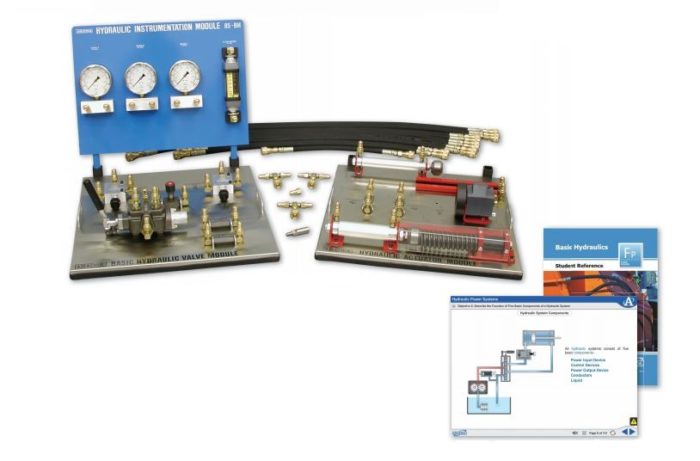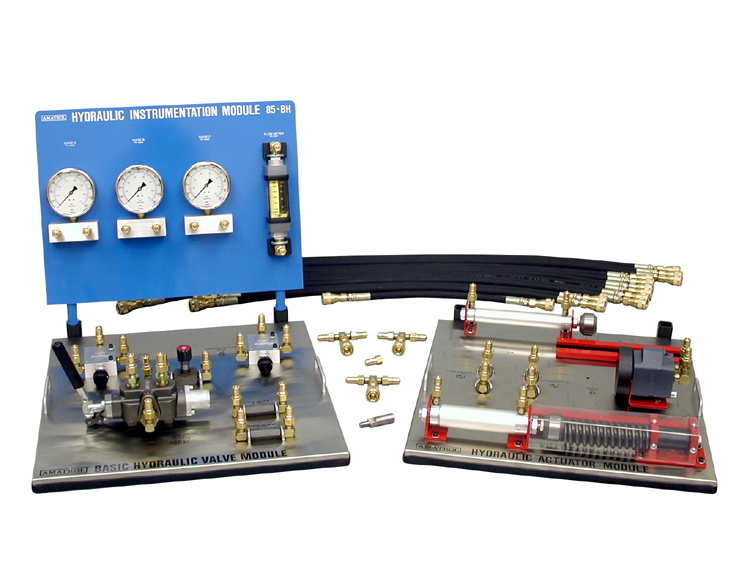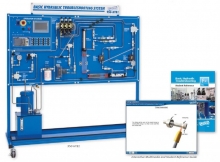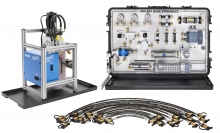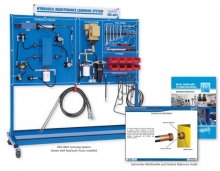Basic Hydraulics Learning System
Because hydraulic power is used in everything from automotive brakes to industrial robots, the skills taught by Amatrol’s Basic Hydraulics Learning System (85-BH) opens doors to careers in fields, such as manufacturing, transportation, agricultural, and construction. Basic Hydraulics training introduces the fundamental hydraulic principles, such as pressure and flow, while simultaneously teaching industry-relevant hydraulic skills; this signature Amatrol approach to curriculum reinforces both theory and practice, which produces a well-rounded understanding of the topic.
Basic Hydraulic training includes gauges, manifolds, cylinders, valves (relief/sequence, pressure reducing, check, directional control), flow meter, and hydraulic motor. These components are all industrial quality to ensure durability and help learners become better prepared for what they will encounter on the job. All Amatrol products are made from top-notch materials and carefully crafted (hand-welded, painted, and silk-screened) to create tough, attractive, well designed industrial training systems that facilitate learning and will serve teachers and students for years.
Real World Industrial Hydraulic Applications
Within the Basic Hydraulics curriculum, students begin studying the physical principles of hydraulics and how hydraulic mechanisms used in real-world applications. From this building block, students begin hydraulic circuit construction, which gradually increases in difficulty and number of industry-standard components as the curriculum goes along. By taking this approach, students will understand each component’s function in a circuit, which makes hydraulic troubleshooting easier in later lessons and on more advanced training systems. Students also study pumps, gauges, hydraulic motors, cylinders, and numerous valves, including schematic symbols for each component, creating the ability to read and draw their own hydraulic schematics.
Industrial Standard Fluid Power Components
Each Basic Hydraulics training system features standard industrial-grade components. This attention to quality gives students experience they would normally only get on-the-job by helping them recognize industrial components and how to troubleshoot them more effectively. Components included with Basic Hydraulics are pre-mounted on circuit panels with silk-screened labels next to each, which facilitates ease of use and identification. Additionally, the system’s orderly, user-friendly design helps learners to easily recognize how each component fits into a hydraulic circuit.
Interactive Online Hydraulics Training Course and Virtual Trainer
Basic Hydraulics Multimedia (NB831)
Within the basic hydraulics training curriculum, students begin by studying the physical principles of hydraulics and how hydraulic mechanisms used in real-world applications. From this building block, learners begin constructing hydraulic circuits, which gradually increase in difficulty and number of industry-standard components as the curriculum goes along. Students will also study pumps, gauges, hydraulic motors, cylinders, and numerous valves, including schematic symbols for each component, creating the ability to read and draw hydraulic schematics. Amatrol’s hydraulics curriculum is presented in an interactive multimedia format. This format features stunning 3D animations, video, voiceovers, and interactive quizzes. This multimedia also includes the basic hydraulics virtual trainer that recreates hydraulic equipment in such realistic detail that learners can seamlessly transition to actual hands-on equipment.
Expanded Teaching Options
Learners can build on the skills they have acquired from Basic Hydraulics by moving onto the Intermediate (85-IH) and Advanced (85-AH) Amatrol Hydraulics, as well as the Electro-Hydraulics (85-EH). For convenience, Amatrol offers Basic Hydraulics (85-BH) as part of the Basic Hydraulics package (850-H1), which also includes an Amatrol workstation (850-CTB) that features welded-steel frame construction for durability, lockable casters for mobility, slide-in storage racks, and the Hydraulic Power Unit (85-HPS).
Learning TopicsStudent Reference GuideKey FeaturesLearning Topics
- Hydraulic Power Systems
- Basic Hydraulic Circuits
- Principles of Hydraulic - Pressure and Flow
- Hydraulic Speed Control
- Pressure Control Circuits
- Pumps
- Hydraulic Schematics
- Relief, Check, and Flow Control Valves
- Meter-In, Meter-Out, and Flow Control Circuits
- Sequence Valves
- Pressure Reducing Valves
- Troubleshooting
Student Reference Guide
A sample copy of the Basic Hydraulics Student Reference Guide is also included with the system for your evaluation. Sourced from the system’s multimedia curriculum, the Student Reference Guide takes the entire series’ technical content contained in the learning objectives and combines them into one bound book.
Key Features
- Industrial Standard Components
- Plug-in Quick Disconnect Connections
- Pre-Mounted Components for quick setup
- Courseware Supported
- Dynamic Load Devices
- Low-Cost
- Portable
- Table-Top or Bench Mount

